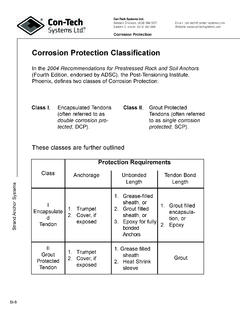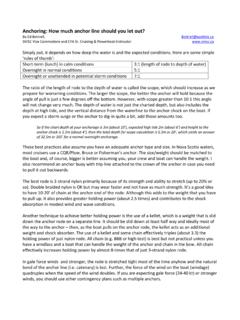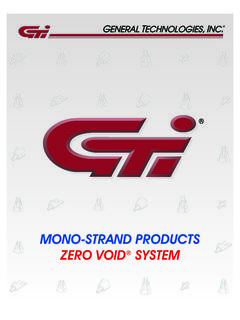Transcription of ACI 423.4R-98 Corrosion and Repair of Unbonded …
1 ACI Corrosion and Repair of Unbonded single strand Tendons Reported by ACIIASCE Committee 423 Charles W. Dolan Chairman Kenneth B. Bondyt Catherine W. French Robert N. Bruce Jr. Clifford Freyermuth Dale C. Buckner William L. Gamble Ned H. urns st Hans R. Ganz Gregory P. ~hacos' Mohammad Iqbal Jack Christiansen Francis J. Jaques Todd Christopherson Daniel P. Jenny Steven R. Close Paul Johal Thomas E. Cousins Susan N. Lane Apostolos Fafitis Ward N. Marianos Jr. Mark W. Fantozzi Leslie D. Martin Martin J. ~raduat Alan H. Mattock 'Co-chairmen of subcommittee responsible for preparation of report ?Member of subcomm~ktee responsible for preparation of report. This report gives general information regarding the evaluation of Corrosion damage in structures reinforced with Unbonded single strandpost-tension- ing tendons. Historical development of those parts of the building code dealing with durability and protection is explained.
2 Evolution of the types and components of Unbonded tendons is described. Specific aspects of Corrosion in Unbonded single strand tendons are described, and common problems in structures reinforced with these tendons are discussed. Methods are presented for I-epairing, replacing, andsupplementing tendons. Keywords: allowable stresses; anchorage; carbonation; concrete con- struction; Corrosion ; Corrosion protection; cover; durability; embrittle- ment; external post-tensioning; grease; inspection; post-tensioned concrete; pre-stressed concrete; Repair ; sheathing; single strand tendons; surveys; tendons; tests; Unbonded post-tensioning. ACI Committee Reports, Guides, Standard Practices, and Commentaries are intended for guidance in planning, design- ing, executing, and inspecting construction. This document is intended for the use of individuals who are competent to evaluate the significance and limitations of its content and recommendations and who will accept responsibility for the application of the material it contains.
3 The American Concrete Institute disclaims any and all responsibility for the stated principles. The Institute shall not be liable for any loss or damage arising therefrom. Reference to this document shall not be made in contract documents. If items found in this document are desired by the ArchitectEngineer to be a part of the contract docu- ments, they shall be restated in mandatory language for in- corporation by the ArchitectIEngineer. Henry J. Cronin Jr. Secretary Gerard J. ~cGuiret David H. Sanders Mark Mooret Thomas C. Schaeffer Antoine E. Naaman Morris Schupack+ Kenneth Napior Kenneth Shushkewich Thomas E. Nehil* Khaled S. Soubra Mrutyunjaya Pani Patrick J. Sullivan Kent H. Preston Luc R. Taenve Denis C. Pu Carl H. Walker Julio A. Ramirez Jim J. Zhao Ken B. Rear Paul Zia David M. Rogowsky Bruce W. Russel CONTENTS Chapter l-lnlro-sducti:%i&rrt, p, 1 .&Limitations Chapter 2-Review of code requirerne~ts and changes, p.
4 Requirements for Unbonded tendons tensile stresses in concrete of Unbonded tendons Chapter 3- Unbonded tendons, p. of Unbonded tendons problems practices 3 .+Storage, handling, and construction problems mechanisms record ACI became effective February 23, 1998. Copyright O 1998, American Concrete Institute. All rights reserved including rights of reproduction and use in any form or by any means, including the making of copies by any photo process, or by electronic or mechanical device, printed, written, or oral, or recording for sound or visual reproduc- tion or for use in any knowledge or ret~ieval system or device, unless permission in writing is obtained from the copyright proprietors. MANUAL OF CONCRETE PRACTICE Fig 3. I-(a) Live end anchorage assembly for button-headed wir~epost-tensioning system; (b) intermediate anchorage assenzbly with threaded coupler I,O& and (c) dead end anchor- age assembly; dimensions "A" and "B" were usually 4 and 6 in.
5 (100 and 150 nznz), respectively, for a typical 7-wire slab tendon (reprinted front Reference I). Initially, there were no Corrosion protection standards for the grease (except in the nuclear industry, refer to ACI 359- 74, "Code for Concrete Reactor Vessels and Containments"), so the tendon manufacturers used the grease of their choice. Corrosion -resisting properties of the grease were not speci- fied, nor were there standards for the uniformity and amount Coated strand Paper-wrapped 1955-1 975+ This ~arfion of sfrand usualiy unsheathed. Lenglh varies. Plastic Sheath 1960-Present coated strand plbstic Shenth Pioslic tube with wotertighl ose Fitting 1985 PTI Recommended / System L7-wire strand with Plclsiic Coo corrasron preventive cooling completely filling annular spoce ~~~h~~~~~ Plostic. qrease filled tube wit6 watertight connection at anchorage. Plastic Cop \ , filled with Electrically grease Isolated tendon Piostic coated completely filling onnulor space anchorage Entire tendon Assembly covered with electrically isolating rnaleriol.
6 Fig. of Corrosion protection for Unbonded sin- gle strand tendons for buildings (reprintedfrom Reference 2). of grease to be applied to the prestressing steel. Deterioration of the grease was not expected, but as problems became known they were addressed by the PTI in their recommended specifications. problems The push-through system required that the sheathing be sufficiently oversized to allow the greased strand to be in- serted without too much difficulty. This resulted in a tendon with many air voids inside the sheathing and allowed infil- tration of water during storage, shipping, and installation, and in service. With the heat-sealed system, the sheathing was provided in rolls of flat plastic tape that was usually 20 to 40 mils ( to mm) thick. During tendon fabrication, the strand would be taken from the pack and passed through a grease extrusion head. The tape was then folded over the greased strand and the lapped seam welded shut with a flame.
7 This method also formed a slightly oversized sheathing that could have air voids. The seam weld was interrupted every time there was a pause in the process, and sometimes the sealed seam pulled apart during handling or installation. This sys- tem is frequently found to have gaps from one cause or an- other that expose the greased strand to contact with the concrete. Seamless extruded sheathing first appeared in the early 1970s.~ The extruded sheathing minimized the problems ex- perienced with the push-through and heat-sealed systems by providing a snug, seamless sheathing around the greased strand . practices Certain details that were initially considered acceptable are insufficient to provide the degree of durability required single strand TENDONS PUSH-THROUGH the unsheathed strand and the hardened concrete is disturbed at the stressing end during this elongation, thus providing a PREFORMED TUBE path for water to find its way to the strand and into the strand PUSHED THROUGH AS GREASE IS APPLIED.
8 Since the dead end anchor did not have to move during HEAT-SEALED FORMED FROM FLAT STRIP AS GREASE IS APPLIED. EXTRUDED FORMED BY EXTRUDING OVER strand AS GREASE IS APPLIED. Fig sheathing types (reprintedfuonz Reference 2) by recent versions of ACI 3 18. It is now recognized that con- crete cannot provide reliable protection to the strand , even if the strand is greased. It was common practice in both detailing and installation to allow the sheathing to stop short of the anchorages, as shown by Fig. (the grease can get wiped away from these sections of strand during the installation of anchorages at and nonstressing ends). During stressing opera- tions, the strand at the stressing end moves about 8 in. per 100 ft (200 mm per 30 m) of length. Direct contact between stressing, it was considered acceptable for the strand near the dead end to be exposed to the concrete.
9 However, this also allowed the end of the tendon to be exposed to dirt and water during storage, handling, and placement, prior to placing the protective concrete. The end of the sheathing was, for prac- tical purposes, open, and the voids inside the tendon sheath- ing provided a means for any available water to gain access to the tendon . Even if the storage time at the site was relative- ly brief (which was not always the case), there was ample op- portunity for water to get into the tendons due to any snow and rain that might occur while the tendons were stored on the ground or on the formwork. For those portions of the strand not adequately protected by grease, water and oxygen could cause Corrosion and then could be further exacerbated by the presence of chloride-ions. Some typical defects con- tributing to Corrosion in the end anchor region are shown in Fig. The stressing side of the live-end anchorage was protected by filling the stressing pocket in which the anchorage was re- cessed with a protective cementitious grout (Fig.)
10 The casting, wedges, and strand tail were not coated. Often, shrinkage of the grout plug in the stressing pocket caused a space between the side of the stressing pocket and the grout that allowed water to gain access to the tendon anchorage. Corrosion of the bearing plate casting is often found but has not been known to cause failures. On tendons with barrel and wedges sitting on bearing plates, heat-treated barrels -.." '4 Chloride ion penetration Cernentitious grout plug at anchorage pocket shrinks and becomes loose. Poor bond andlor poor quality mortar permits aggressive materials access to anchorage and prestressing steel. Shallow cover to pre- stressing steel allows Corrosion to start or chloride ion penetrates and starts stub Corrosion . Portlon of strand covered wlth grease exposed to concrete because no physical connectton IS made between sheath and anchorage.





